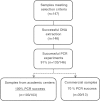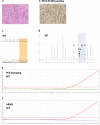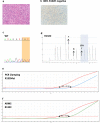A new sensitive PCR assay for one-step detection of 12 IDH1/2 mutations in glioma
- PMID: 24889502
- PMCID: PMC4229941
- DOI: 10.1186/2051-5960-2-58
A new sensitive PCR assay for one-step detection of 12 IDH1/2 mutations in glioma
Abstract
Introduction: Mutations in isocitrate dehydrogenase genes IDH1 or IDH2 are frequent in glioma, and IDH mutation status is a strong diagnostic and prognostic marker. Current IDH mutation screening is performed with an immunohistochemistry (IHC) assay specific for IDH1 R132H, the most common mutation. Sequencing is recommended as a second-step test for IHC-negative or -equivocal cases. We developed and validated a new real-time quantitative polymerase chain reaction (PCR) assay for single-step detection of IDH1 R132H and 11 rare IDH1/2 mutations in formalin-fixed paraffin-embedded (FFPE) glioma samples. Performance of the IDH1/2 PCR assay was compared to IHC and Sanger sequencing.
Results: The IDH1/2 PCR assay combines PCR clamping for detection of 7 IDH1 and 5 IDH2 mutations, and Amplification Refractory Mutation System technology for specific identification of the 3 most common mutations (IDH1 R132H, IDH1 R132C, IDH2 R172K). Analytical sensitivity of the PCR assay for mutation detection was <5% for 11/12 mutations (mean: 3.3%), and sensitivity for mutation identification was very high (0.8% for IDH1 R132H; 1.2% for IDH1 R132C; 0.6% for IDH2 R172K). Assay performance was further validated on 171 clinical glioma FFPE samples; of these, 147 samples met the selection criteria and 146 DNA samples were successfully extracted. IDH1/2 status was successfully obtained in 91% of cases. All but one positive IDH1 R132H-IHC cases were concordantly detected by PCR and 3 were not detected by sequencing. Among the IHC-negative cases (n = 72), PCR detected 12 additional rare mutations (10 IDH1, 2 IDH2). All mutations detected by sequencing (n = 67) were concordantly detected by PCR and 5/66 sequencing-negative cases were PCR-positive (overall concordance: 96%). Analysis of synthetic samples representative of the 11 rare IDH1/2 mutations detected by the assay produced 100% correct results.
Conclusions: The new IDH1/2 PCR assay has a high technical success rate and is more sensitive than Sanger sequencing. Positive concordance was 98% with IHC for IDH1 R132H detection and 100% with sequencing. The PCR assay can reliably be performed on FFPE samples and has a faster turnaround time than current IDH mutation detection algorithms. The assay should facilitate implementation of a comprehensive IDH1/2 testing protocol in routine clinical practice.
Figures






Similar articles
-
Determining IDH-Mutational Status in Gliomas Using IDH1-R132H Antibody and Polymerase Chain Reaction.Appl Immunohistochem Mol Morphol. 2019 Nov/Dec;27(10):722-725. doi: 10.1097/PAI.0000000000000702. Appl Immunohistochem Mol Morphol. 2019. PMID: 30358614
-
Comparison of Polymerase Chain Reaction-Restriction Fragment Length Polymorphism, Immunohistochemistry, and DNA Sequencing for the Detection of IDH1 Mutations in Gliomas.Asian Pac J Cancer Prev. 2020 Nov 1;21(11):3229-3234. doi: 10.31557/APJCP.2020.21.11.3229. Asian Pac J Cancer Prev. 2020. PMID: 33247679 Free PMC article.
-
Clinicopathological and Molecular Profiling of Adult-Type Diffuse Glioma Using Immunohistochemistry and Real-Time Polymerase Chain Reaction: Study from a Tertiary Care Cancer Center in Western India.Neurol India. 2025 Jul 1;73(4):704-709. doi: 10.4103/neurol-india.Neurol-India-D-24-00163. Epub 2025 Jul 24. Neurol India. 2025. PMID: 40705285
-
Specific monoclonal antibodies against IDH1/2 mutations as diagnostic tools for gliomas.Brain Tumor Pathol. 2015 Jan;32(1):3-11. doi: 10.1007/s10014-014-0202-4. Epub 2014 Oct 17. Brain Tumor Pathol. 2015. PMID: 25324168 Review.
-
Isocitrate dehydrogenase 1 and 2 mutations in gliomas.J Neurosci Res. 2014 Dec;92(12):1611-20. doi: 10.1002/jnr.23456. Epub 2014 Jul 31. J Neurosci Res. 2014. PMID: 25078896 Review.
Cited by
-
Characterization of an IDH1 R132H Rabbit Monoclonal Antibody, MRQ-67, and Its Applications in the Identification of Diffuse Gliomas.Antibodies (Basel). 2023 Feb 6;12(1):14. doi: 10.3390/antib12010014. Antibodies (Basel). 2023. PMID: 36810519 Free PMC article.
-
IDH mutation, 1p19q codeletion and ATRX loss in WHO grade II gliomas.Oncotarget. 2015 Oct 6;6(30):30295-305. doi: 10.18632/oncotarget.4497. Oncotarget. 2015. PMID: 26210286 Free PMC article.
-
Recent Advances on the Molecular Pathology of Glial Neoplasms in Children and Adults.J Mol Diagn. 2016 Sep;18(5):620-634. doi: 10.1016/j.jmoldx.2016.05.005. J Mol Diagn. 2016. PMID: 27444975 Free PMC article. Review.
-
Beyond Brooding on Oncometabolic Havoc in IDH-Mutant Gliomas and AML: Current and Future Therapeutic Strategies.Cancers (Basel). 2018 Feb 11;10(2):49. doi: 10.3390/cancers10020049. Cancers (Basel). 2018. PMID: 29439493 Free PMC article. Review.
-
Molecular Biomarker Testing for the Diagnosis of Diffuse Gliomas.Arch Pathol Lab Med. 2022 May 1;146(5):547-574. doi: 10.5858/arpa.2021-0295-CP. Arch Pathol Lab Med. 2022. PMID: 35175291 Free PMC article.
References
-
- Hartmann C, Meyer J, Balss J, Capper D, Mueller W, Christians A, Felsberg J, Wolter M, Mawrin C, Wick W, Weller M, Herold-Mende C, Unterberg A, Jeuken JW, Wesseling P, Reifenberger G, von Deimling A. Type and frequency of IDH1 and IDH2 mutations are related to astrocytic and oligodendroglial differentiation and age: a study of 1,010 diffuse gliomas. Acta Neuropathol. 2009;118(4):469–474. doi: 10.1007/s00401-009-0561-9. - DOI - PubMed
Publication types
MeSH terms
Substances
Grants and funding
LinkOut - more resources
Full Text Sources
Other Literature Sources
Medical
Miscellaneous

